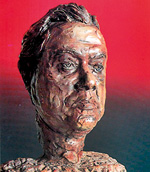Sunday Times 2
Remembering a patron of the fine arts
Prof. Senaka Bandaranayake (1938-2015) was famous as a university professor who could be seen at both professional and amateur art exhibitions. He would walk around at these exhibitions, question, criticize and appreciate the works of visual art. Among university professors of other disciplines not related to visual arts, he had the most sensitive nature towards visual arts. He was a great scholar and an archeologist. He was duly respected by all students. Although his service towards his field, archeology is immeasurable, his contribution towards Sri Lankan visual arts is also invaluable.

A portrait sculpture of Senaka Bandaranayake - created in 1991 by sculptor artist Sarath Chandrajeewa. This was exhibited at the exhibition 'Hundred Impressions in Bronze' which was held at National Art Gallery, Colombo in 1994. Pic Nihal Fernando
The book he had co-authored with Gamini Jayasinghe in 1986, ‘The Rock and Wall Paintings of Sri Lanka’ has since been a handbook on Sri Lankan frescoes and wall paintings to all scholars, students and artists. This book is source material for this subject. If we evaluate the contribution of this work to the subject of visual art, it can be equaled to Dr. Ananda K. Coomaraswamy’s contribution towards Sri Lankan craft, by publishing ‘Mediaeval Sinhalese Art’, the repository of applied art in Sri Lanka, in 1908.
He had been collecting visual art work of contemporary painters from 1990 for the Presidential Collection of the Democratic Socialist Republic of Sri Lanka when former President Chandrika Bandaranaike was in office. The selected paintings are now at the Presidential House. Information regarding this collection has been recorded in ‘Contemporary Sri Lanka Art – The Presidential Collection’ published by the Presidential Secretariat in 2008.
He, together with his wife Manel Fonseka authored a book in 1996 titled ‘Ivan Peries Paintings: 1938-88′ regarding painter Ivan Peries, a member of the ’43 Group’ thus, filling a void in Modern History of Art in Sri Lanka.
He did a great service to Sri Lankan contemporary art by publishing ‘Sri Lankan Painting in the 20th Century’ co-authored with Professor Albert Dharmasiri in 2009. This book has greatly influenced young and upcoming artists especially as there are no museums to showcase modern art in Sri Lanka. He had also written various articles on visual art and crafts. Articles he had written for the Mawatha magazine at a certain time have opened the way to think again of the culture of this country.
The Post Graduate Institute of Archeology of the University of Kelaniya, which he was the founder, has paved the way for visual art graduates also to research on artifacts relating to archeology.
He was the foremost person in the effort of upgrading the Institute of Aesthetic Studies of the University of Kelaniya, which had a long history in art education in Sri Lanka, to a fully fledged university. During this period his cousin Chandrika Bandaranaike Kumaratunga was the president of the country. The other members of the committee which had been formed to make a report on this matter were Professor Tissa Kariyawasam and Professor Walter Marasinghe. The draft to establish the University of the Visual and Performing Arts by upgrading the Institute of Aesthetic Studies was drawn aimed at Professor Bandaranayake’s vision and objectives. The University of the Visual and Performing Arts gained independent university status on July 1, 2005, mainly due to his direct involvement.
Following in the footsteps of pioneer archeologists H.C.P. Bell, Senarath Paranavithana, Charles Godakumbura, Raja de Silva and Roland de Silva, Prof. Senaka Bandaranayake who had worked tirelessly for Archeology in Sri Lanka, has contributed greatly in making Sigiriya a UNESCO world heritage site. This includes establishing Sigiriya Museum too.
Though he had held various posts as, head of the Archeology Department of the University of Kelaniya, Vice-Chancellor of the same university, Sri Lankan High Commissioner in India and UNESCO Sri Lankan Representative in France, in this article he is appreciated as a beloved professor with a sensitive nature towards fine arts in Sri Lanka.
(The writer is the Dean of the Faculty of Graduate Studies at the University of Visual and Performing Arts.)

